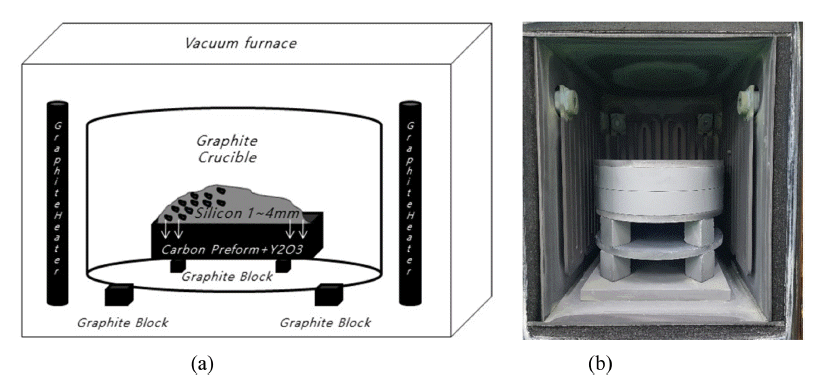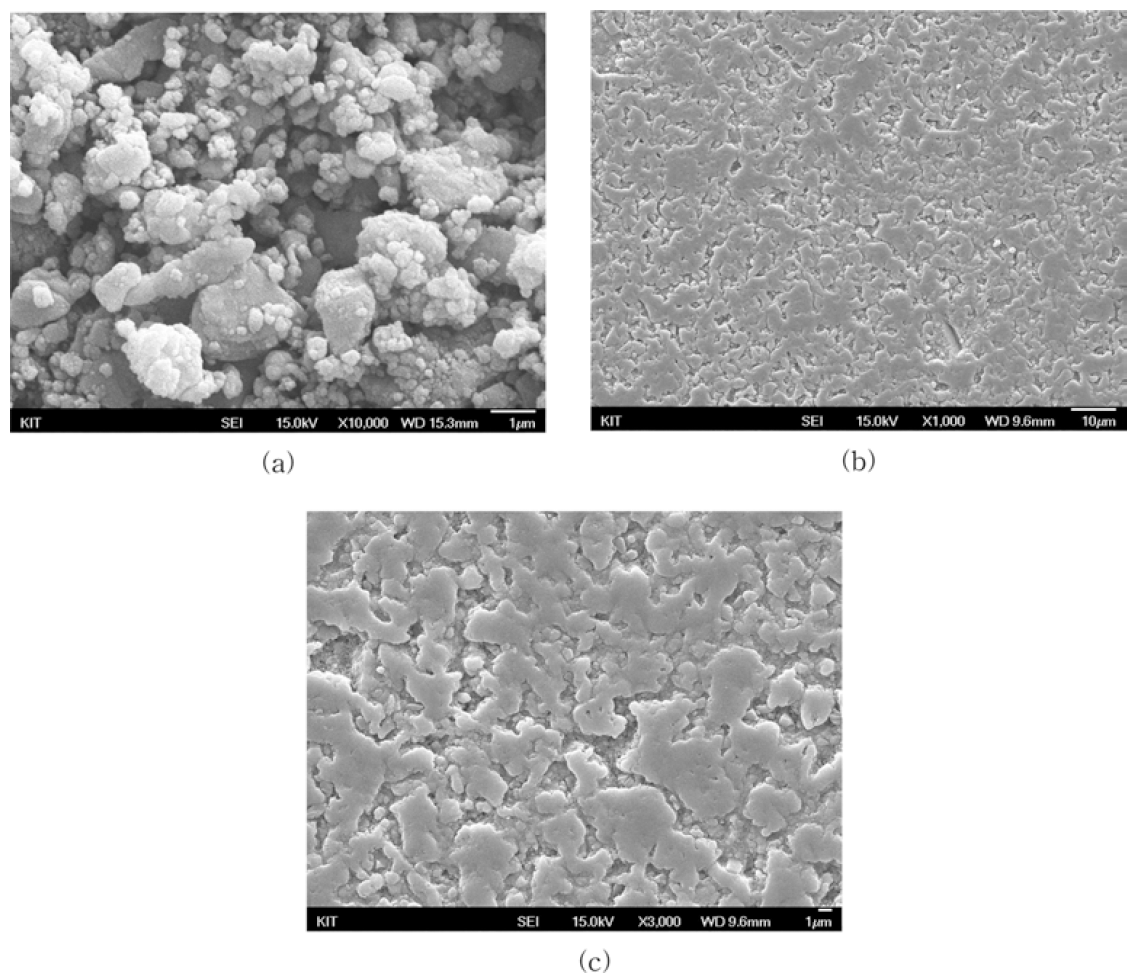- [Korean]
- RBSC Prepared by Si Melt Infiltration into the Y2O3 Added Carbon Preform
-
Min-Ho Jang, Kyeong-Sik Cho
-
J Korean Powder Metall Inst. 2021;28(1):51-58. Published online February 1, 2021
-
DOI: https://doi.org/10.4150/KPMI.2021.28.1.51
-
-
 Abstract Abstract
 PDF PDF
The conversion of carbon preforms to dense SiC by liquid infiltration is a prospectively low-cost and reliable method of forming SiC-Si composites with complex shapes and high densities. Si powder was coated on top of a 2.0wt .% Y2O3-added carbon preform, and reaction bonded silicon carbide (RBSC) was prepared by infiltrating molten Si at 1,450°C for 1-8 h. Reactive sintering of the Y2O3-free carbon preform caused Si to be pushed to one side, thereby forming cracking defects. However, when prepared from the Y2O3-added carbon preform, a SiC-Si composite in which Si is homogeneously distributed in the SiC matrix without cracking can be produced. Using the Si + C → SiC reaction at 1,450°C, 3C and 6H SiC phases, crystalline Si, and Y2O3 were generated based on XRD analysis, without the appearance of graphite. The RBSC prepared from the Y2O3-added carbon preform was densified by increasing the density and decreasing the porosity as the holding time increased at 1,450°C. Dense RBSC, which was reaction sintered at 1,450°C for 4 h from the 2.0wt.% Y2O3-added carbon preform, had an apparent porosity of 0.11% and a relative density of 96.8%.
- [Korean]
- Multicomponent IGZO Ceramics for Transparent Electrode Target Fabricated from Oxides and Nitrates
-
Hyun-Kwun Lee, Ji-Hye Yoon, Kyeong-Sik Cho
-
J Korean Powder Metall Inst. 2019;26(5):375-382. Published online October 1, 2019
-
DOI: https://doi.org/10.4150/KPMI.2019.26.5.375
-
-
 Abstract Abstract
 PDF PDF
Homogeneous multicomponent indium gallium zinc oxide (IGZO) ceramics for transparent electrode targets are prepared from the oxides and nitrates as the source materials, and their properties are characterized. The selected compositions were In2O3:Ga2O3:ZnO = 1:1:2, 1:1:6, and 1:1:12 in mole ratio based on oxide. As revealed by X-ray diffraction analysis, calcination of the selected oxide or nitrides at 1200°C results in the formation of InGaZnO4, InGaZn3O6, and InGaZn5O8 phases. The 1:1:2, 1:1:6, and 1:1:12 oxide samples pressed in the form of discs exhibit relative densities of 96.9, 93.2, and 84.1%, respectively, after sintering at 1450°C for 12 h. The InGaZn3O6 ceramics prepared from the oxide or nitrate batches comprise large grains and exhibit homogeneous elemental distribution. Under optimized conditions, IGZO multicomponent ceramics with controlled phases, high densities, and homogeneous microstructures (grain and elemental distribution) are obtained.
- [Korean]
- Consolidation to Bulk Ceramic Bodies from Oyster Shell Powder
-
Kyeong-Sik Cho, Hyun-Kwuon Lee, Jae Hong Min
-
J Korean Powder Metall Inst. 2016;23(3):221-227. Published online June 1, 2016
-
DOI: https://doi.org/10.4150/KPMI.2016.23.3.221
-
-
 Abstract Abstract
 PDF PDF
Waste oyster shells create several serious problems; however, only some parts of them are being utilized currently. The ideal solution would be to convert the waste shells into a product that is both environmentally beneficial and economically viable. An experimental study is carried out to investigate the recycling possibilities for oyster shell waste. Bulk ceramic bodies are produced from the oyster shell powder in three sequential processes. First, the shell powder is calcined to form calcium oxide CaO, which is then slaked by a slaking reaction with water to produce calcium hydroxide Ca(OH)2. Then, calcium hydroxide powder is formed by uniaxial pressing. Finally, the calcium hydroxide compact is reconverted to calcium carbonate via a carbonation reaction with carbon dioxide released from the shell powder bed during firing at 550°C. The bulk body obtained from waste oyster shells could be utilized as a marine structural porous material.
|





